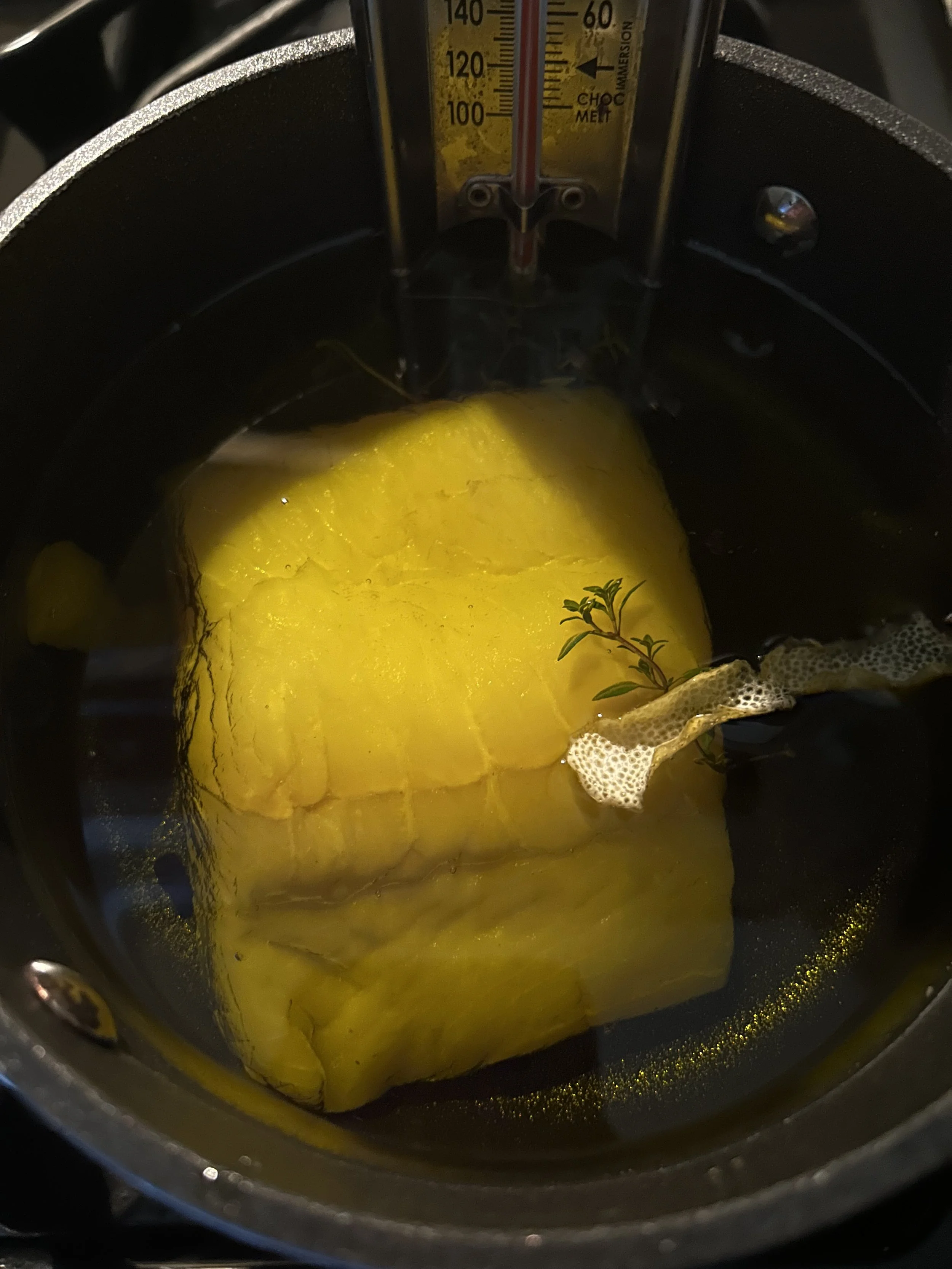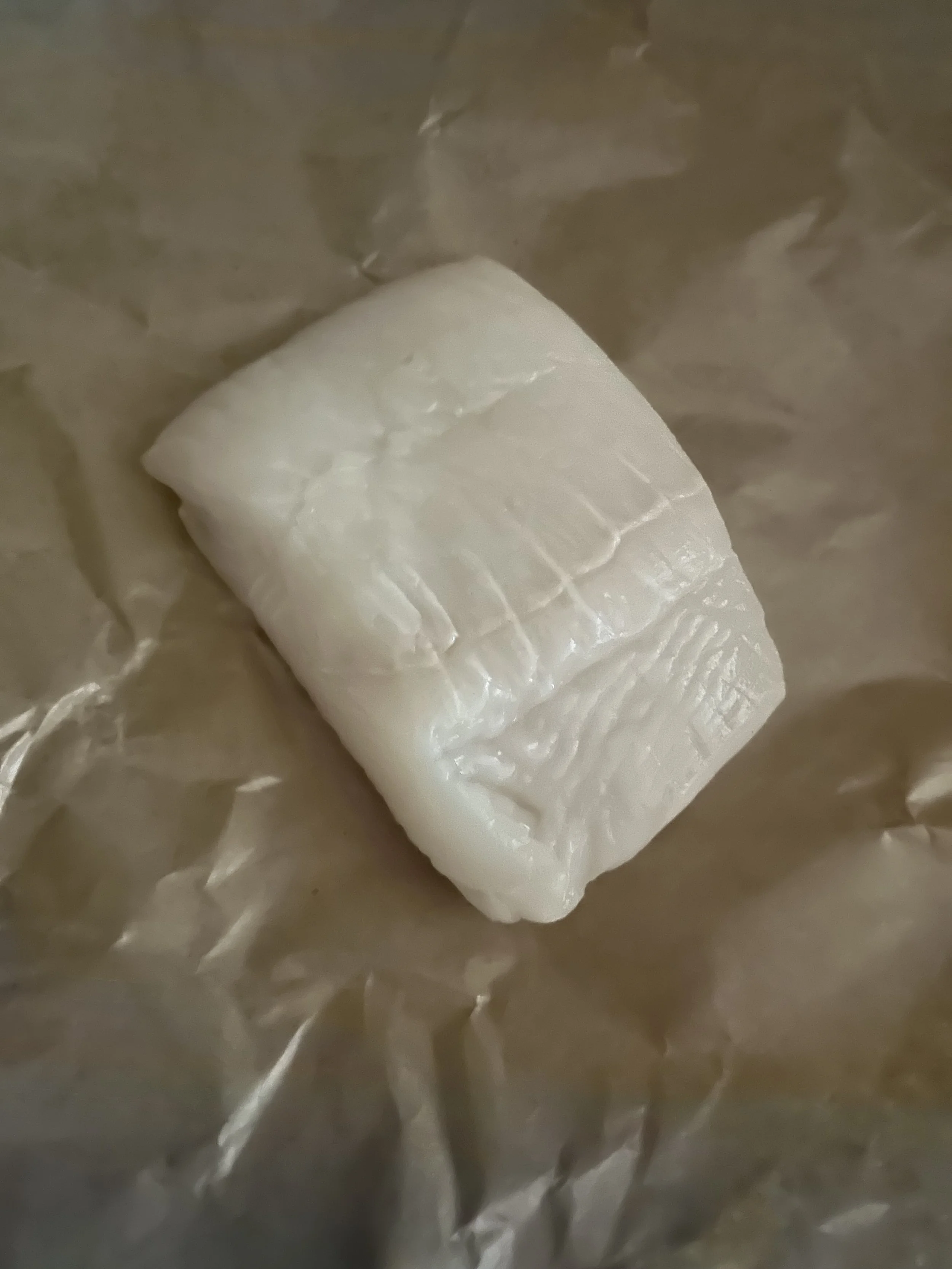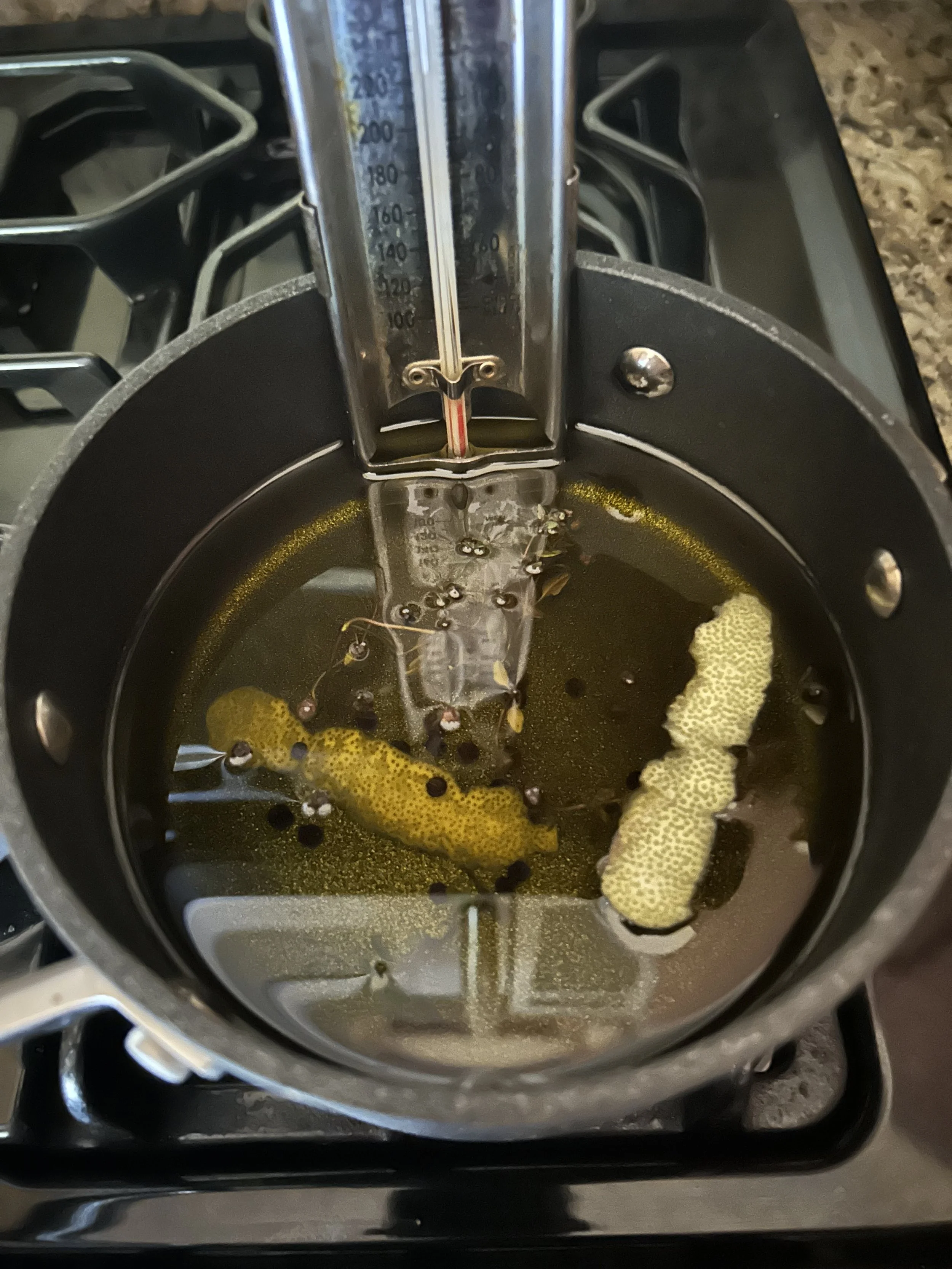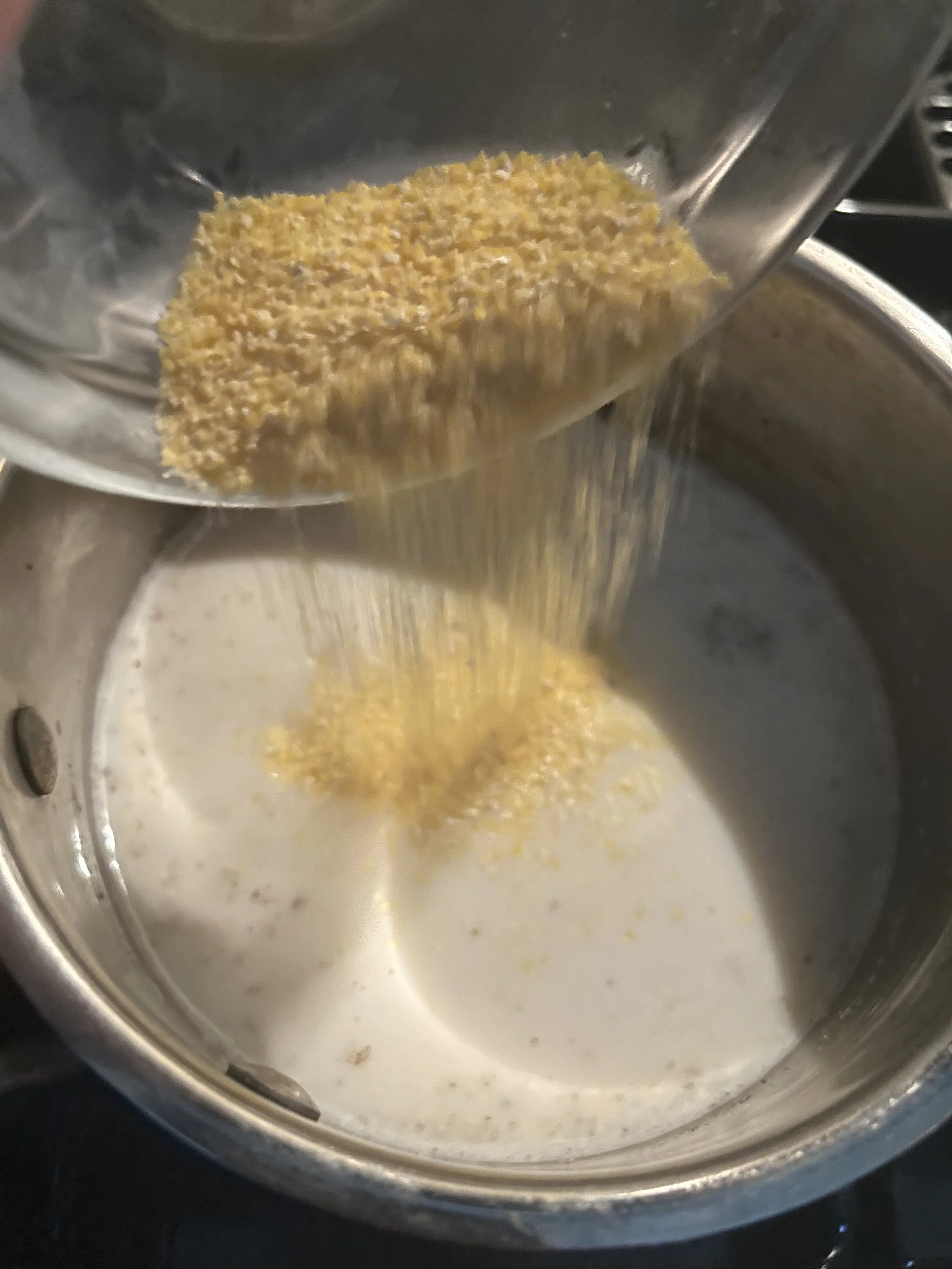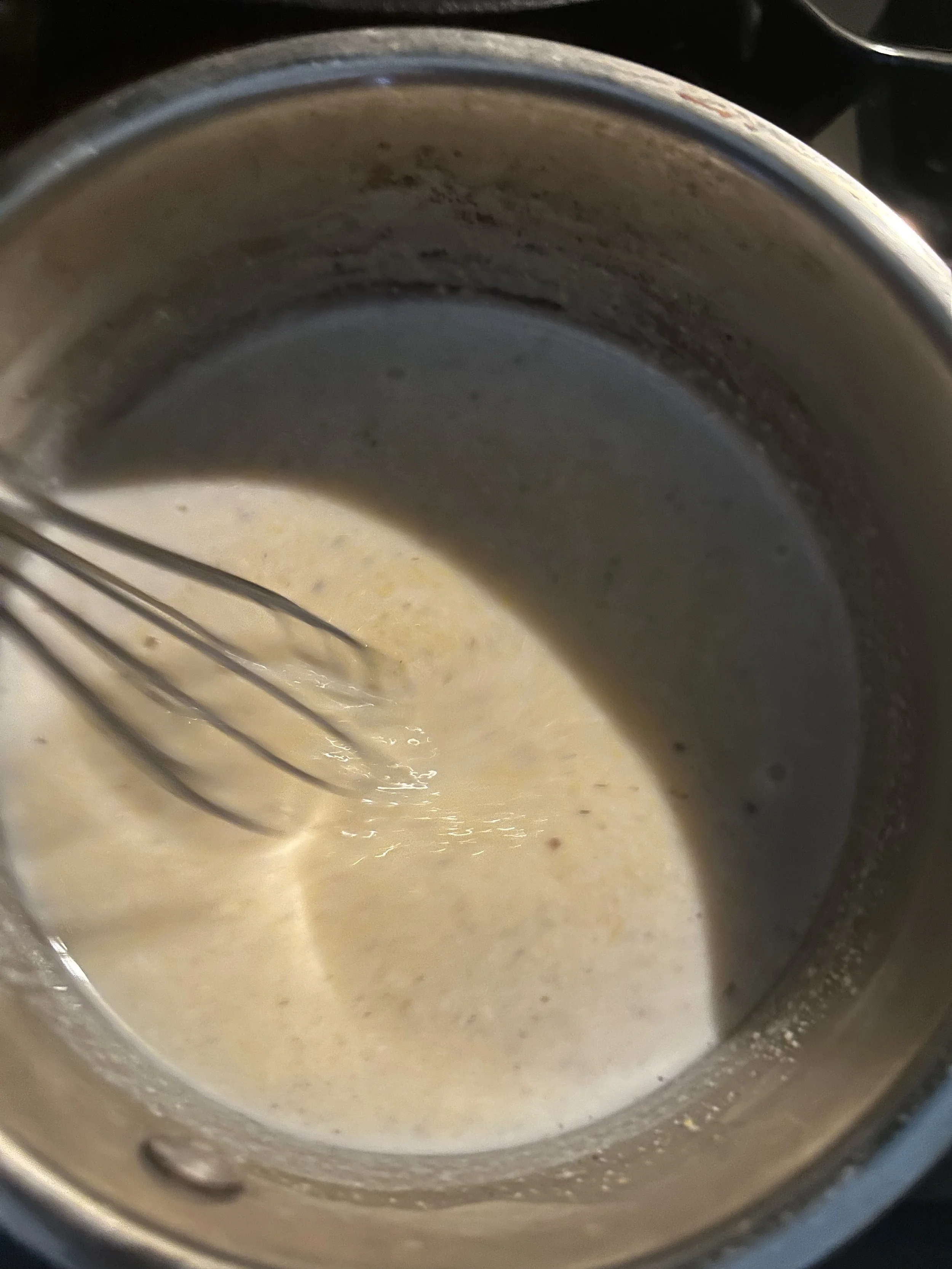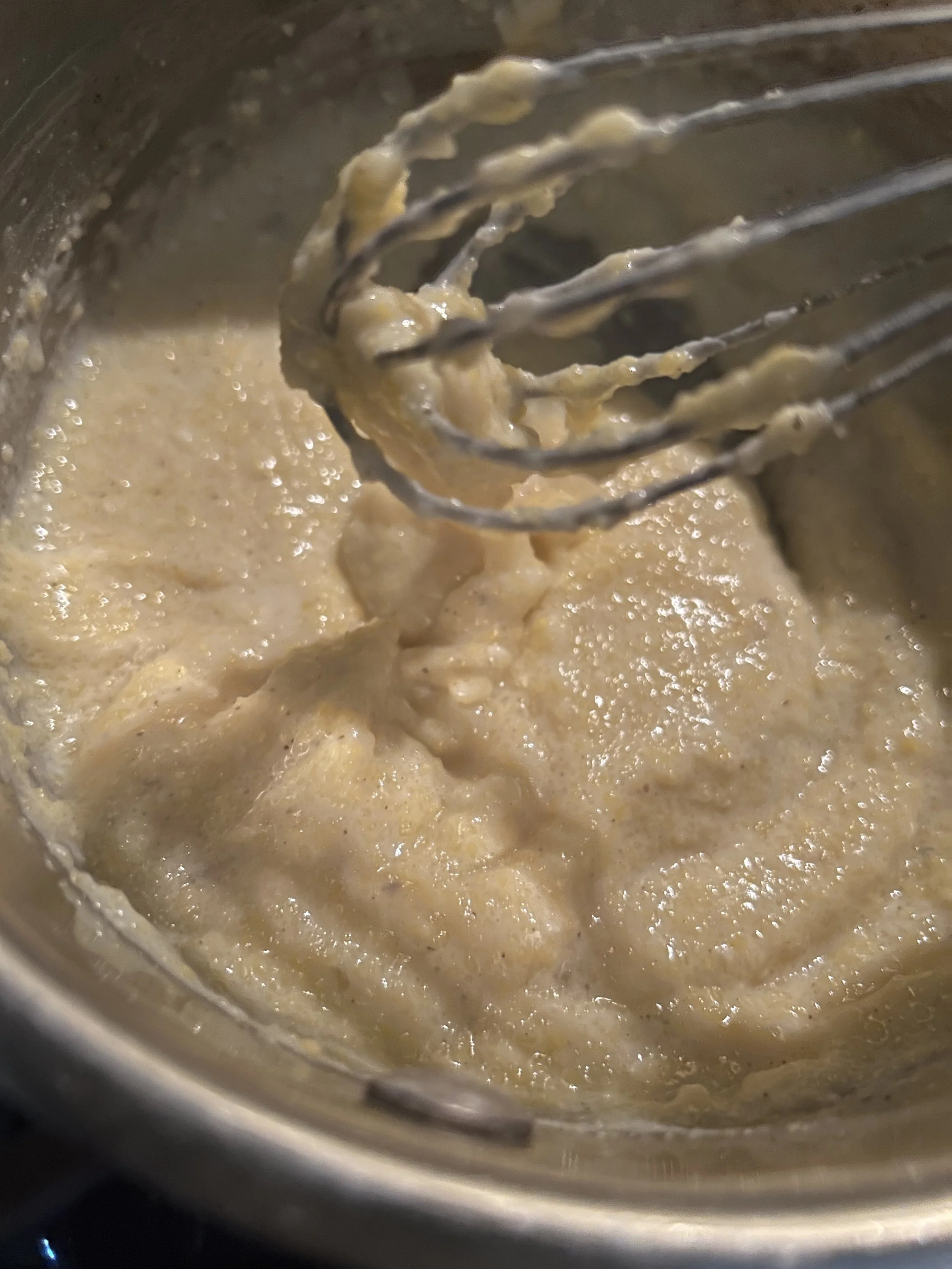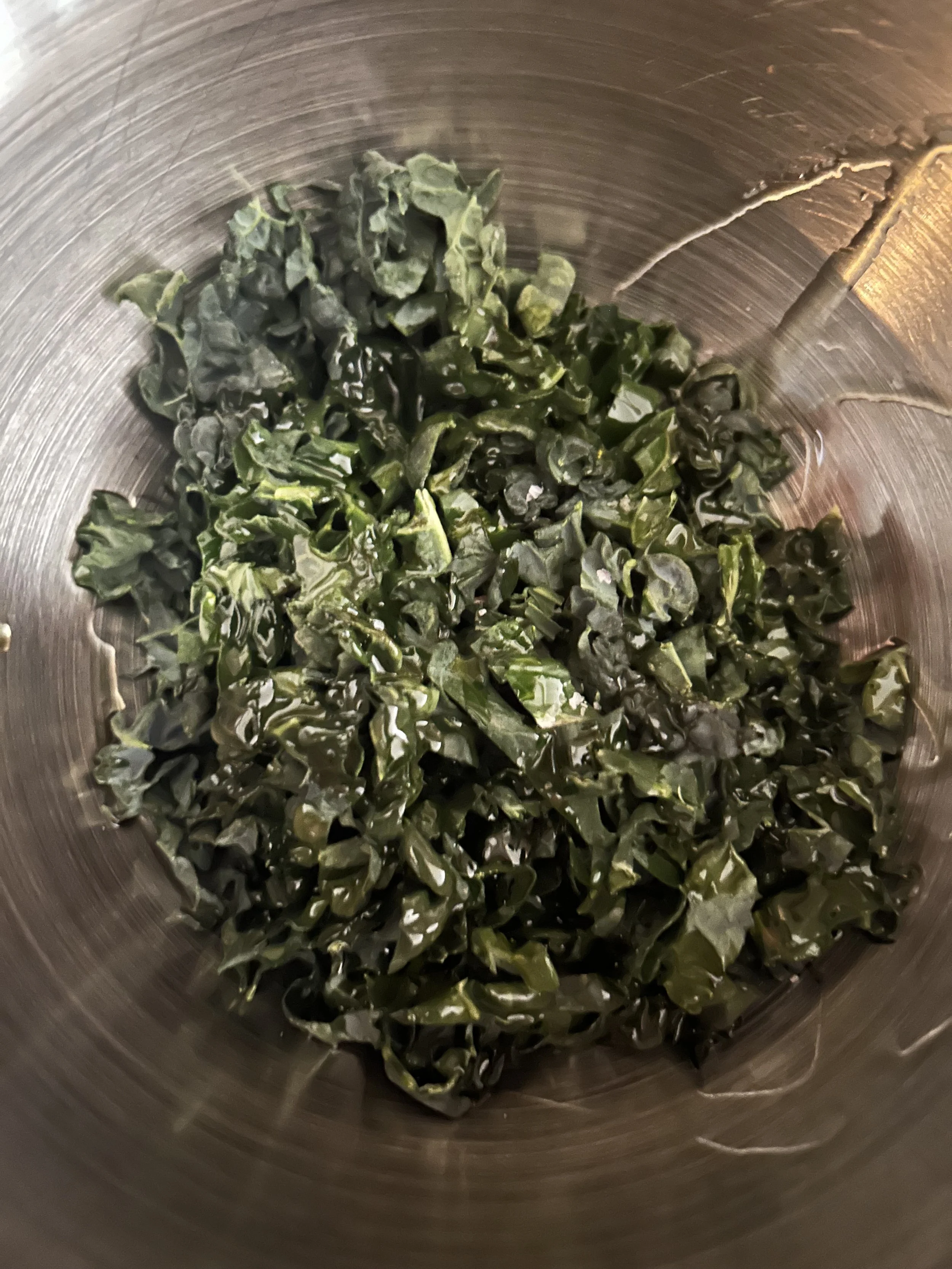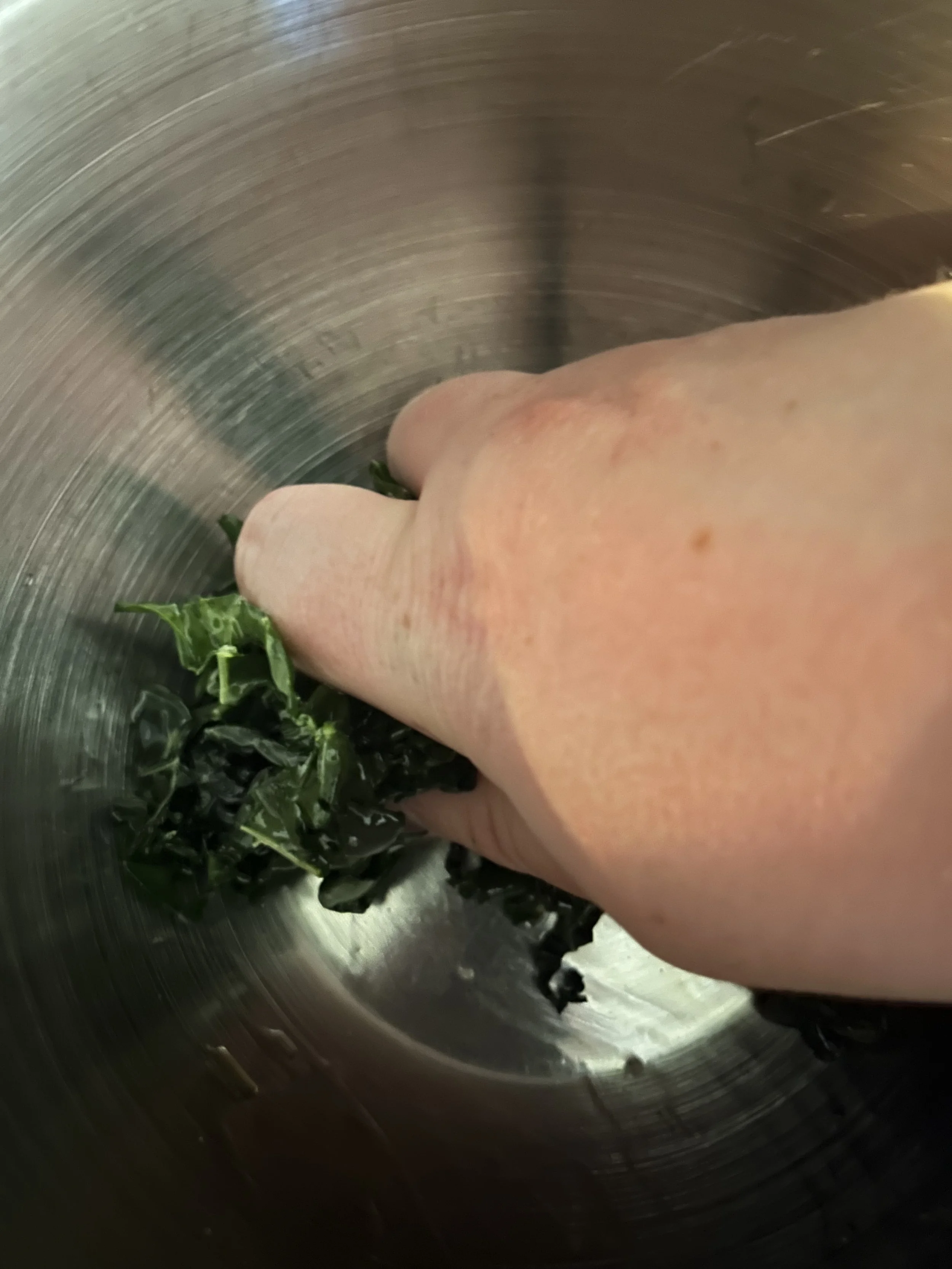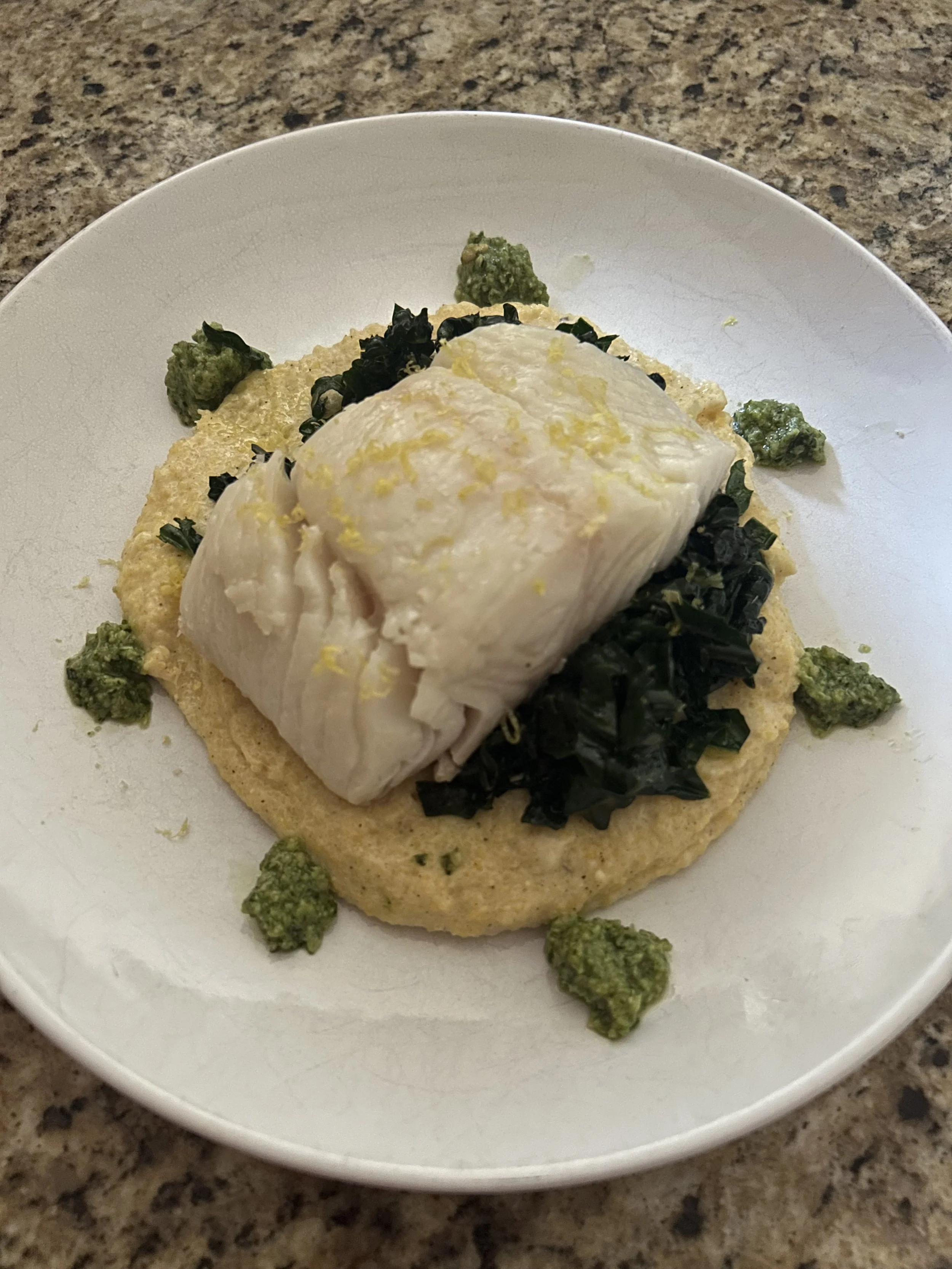Oil Poached Halibut
Hello, readers, hope you’re doing well!
Today, I am going to show you how to do a technical but delicious dish, I am going to be making olive oil poached fish. The idea of poaching fish in olive oil is to slowly cook the fish, get it nice and tender, and infuse it with some great flavor.
It’s a technique that I have not attempted yet, myself, but I have seen other people do it and I think I understand the process enough to do it myself! I’ll be serving it with some creamy polenta and oil-marinated kale.
Not to be confused with the term for illegally hunting animals, poaching is one of the more delicate forms of cooking.
It means submerging something in liquid or oil and cooking that on a low heat to gently infuse with flavor, we do it with gentle and delicate foods like eggs, fish, and tender cuts of pork.
When it comes to oil poaching, there are a few things that can easily go wrong.
The main concern is that if the oil gets too hot, then it’s basically deep frying. I like fried food, but that’s not what I’m going for here.
My hope is that I will be able to properly poach my fish to get it tender, flaky, and very flavorful.
So what kinds of fish can you poach? Well, the good news is that there are many fish that are suitable for oil poaching. Lean fish like cod, haddock, and sea bass, and also fatty fish like salmon or tuna are all acceptable for poaching.
Today, I’ll be poaching some light and delicate halibut as I do enjoy its flavor, but any fresh fish from your fishmonger or the fish counter in the grocery store will work.
How can you tell if your fish is fresh? Simple, give it a smell. Fresh fish should have no lingering odors or blemishes, it should mostly smell like nothing.
Also, if your fish has skin on it, then you can leave it on for the poaching process as the skin will prevent the fish from falling apart in the oil, but you will want to remove it once the fish is cooked as the slow poaching process will cause that fish skin to be quite flabby.
Luckily, once poached, the skin can be pulled off like a banana peel.
With all of that said, let’s get this started!
(For a shortened recipe, you can head towards the bottom of the page)
To get started, I’m gong to set up the poaching pot for my halibut. I want enough olive oil to fully submerge my fish by about an inch, so looking at the thickness of my halibut filet, I’d say I need to fill my pot with at least 2 inches of oil.
I’m then going to gently heat the oil over low heat.
If you have a deep fry/candy thermometer, then that’s the perfect tool for this job. For poaching, you want the oil to be at a maximum of 150 degrees F (65 C); that temperature is warm enough to cook the fish but not so hot that the oil would smoke or end up frying the fish.
If the oil does happen to go above 150, then take it off the heat for a few minutes and let it come back down.
I’m also going to infuse my oil with some lovely flavors, which will infuse the fish with even more flavor. Halibut is a very delicate, mild-flavored fish so I want to think of using delicate spices and herbs.
I’m going to use a few strips of lemon peel, some peppercorns, and a few sprigs of thyme. I add these in before putting the oil onto the heat so the flavor can infuse.
Once my oil has almost reached 150 degrees, I then gently lower my fish into the pot, topping it with more oil if I need to. As soon as that cold fish goes into the hot oil, the temperature will drop a bit, so I’m going to turn the heat back up a little bit and try to maintain that 150 degrees.
I’m going to poach my halibut for 8-12 minutes, or until the fish is fully cooked. I’m going to keep a close ear on it, for if I hear the fish sizzling, then I know that the heat is getting too high and I’ll need to back it down. I can also add a bit of cold oil if the heat is getting too high as well.
While the fish is poaching, I’m going to turn my attention to my polenta. For those who don’t know, polenta is an Italian corn mush made from coarse-ground cornmeal.
Those who live in the southern US will likely think it sounds oddly familiar to their corn mush dish known as grits, and well…that’s because they’re basically the same.
Polenta is often made with yellow cornmeal while grits are made with white cornmeal, but besides that, the two are essentially the same.
Whether you call it grits or polenta, you can rest easy knowing that it’s very easy to make.
For creamy polenta, I will to start by heating up 1/2 cup of milk and 1/2 cup of water. You could use all water for this, especially if you’re serving someone who is vegan or has a dairy allergy, but I like the added richness that the milk provides.
Once the liquid was hot but not boiling, I thenI will whisked in 1/4 cup of stone-ground polenta.
This sounds like a small amount of polenta for the amount of liquid that I started with, but keep in mind that polenta is made with corn and corn is a starch and starch molecules need room to expand and hydrate. Besides, for the creamy consistency I’m going for, this amount of liquid is necessary.
While continuously whisking, I cook the polenta over medium heat for about 5-10 minutes. You’ll know it’s done when most of the liquid is absorbed and, when you taste a bit, there’s no gritty texture.
Once the polenta was cooked, I then took it off the heat, covered it, and let it rest for a few minutes. Just like with cooking rice, you want to let the polenta relax for a bit after cooking so it’ll be creamier and fluffier.
From there, I season my polenta with salt, pepper, some butter, and a lot of grated parmesan, and that’s it! Beautiful polenta!
Ok, the fish is cooked and the polenta is done, I’m going to gently remove the fish from the oil and transfer it to a small plate lined with paper towels to remove any excess oil.
I let the fish rest for a few minutes while I work on the final component of my dish, the kale.
Fad trend or not, kale is delicious, nutritious, and here to stay, so we might as well know how to use it right.
If you’ve never tried olive oil-marinated kale, then you are seriously missing out. Massaging olive oil into the kale leaves infuses it with flavor and also breaks it down to become much more tender.
All I need to do is thinly slice a few leaves of Tuscan kale, any kale variety will work for this, then put those kale leaves into a bowl. I then add some salt and olive oil and use my hands to massage and rub the oil into the kale.
You really do need to give the kale a good massage, about a minute or two of continuous squeezing and rubbing, but it is so worth it! You’ll notice the kale wilt a bit and get a bit darker in color, that’s how you know the oil has penetrated the cell walls of the kale and has made it very tender.
You can add other vegetables or vinegar to this to turn it into a full salad, but I just added a bit of lemon juice to brighten it up.
Ok, I do want to work on my presentation skills a bit, anyone who has seen the cover for my cola braised short rib article will likely understand, so here we go.
I start by placing a bed of my polenta on the plate, mounding it up a bit to give it more height, before adding on my beautiful kale and topping with the halibut.
For garnish, I dot some pesto that I made around the rim of my polenta as well as a dusting of lemon zest on top. Pesto is not a new concept for me, but I had some basil that was close to going bad, so I decided to whip it up into pesto!
I did make this pesto a bit on the lemony side as I needed some acidity to balance out the whole dish.
And there we go, beautiful olive oil-poached fish with creamy polenta and marinated kale!
The fish was beautifully tender, you almost don’t need teeth to eat it, the polenta gave a nice creaminess, the kale provided some brightness and balancing bitter notes, and that stunning pesto made this a dish to remember!
Olive Oil Poached Halibut with Polenta and Kale
Servings: 4
For the fish:
Olive oil, for poaching
4 strips of lemon zest
2 large sprigs of thyme
1 tablespoon of peppercorns
4 6-ounce halibut filets
salt
For the Polenta:
2 cups of milk
Salt and pepper
1 cup of quick-cooking polenta
2 tablespoons of unsalted butter
1/2 cup of grated parmesan cheese
For the Kale:
2 bunches of Tuscan kale, stems removed and leaves thinly sliced.
1/4 cup of olive oil
Salt
2 teaspoons of lemon juice
For garnish:
1/2 cup of basil pesto (homemade or store-bought)
2 teaspoons of lemon juice, plus 2 teaspoons of grated lemon zest
Fill a wide pot with 1 1/2-2 inches of oil and heat to 150 degrees with a fry thermometer, along with the lemon peel, thyme, and peppercorns. (if the oil gets above 150 degrees, then take the pot off the heat for a few minutes.)
Meanwhile, Bring the milk and 2 cups of water to a simmer in a separate pot. Season with salt and pepper.
Pat the halibut filets dry with paper towels, then once the oil gets up to temperature, gently lower the fish in and cook for 8-12 minutes, or until the fish is fully cooked. If the fish is not fully submerged, then top with more oil.
(Keep an eye on that thermometer and adjust the heat if the oil temperature gets anywhere above 150 or below 145)
While the fish is poaching, whisk the polenta into the hot milk and cook over medium heat for 5-10 minutes, or until the liquid is absorbed and the polenta no longer tastes gritty.
Cover the polenta and let it rest for a few minutes, then whisk in the butter and parmesan until melted and smooth, then season to taste.
Once the halibut is cooked, use a slotted spoon to gently remove the fish and place it onto a plate lined with paper towels to remove any excess oil. Sprinkle with salt, then let the fish rest for at least 3 minutes.
(Now would be a good time to peel away any skin that the fish might have)
Place the kale into a medium bowl, then add the 1/4 cup of oil and a pinch of salt then use your hands to massage the kale for at least 2 minutes, or until the kale is wilted.
Mix the pesto with the lemon juice, then get to the plating.
Divide the polenta among 4 plates, top with the kale, a piece of fish, and dot the pesto around the edges of the polenta. Serve with the lemon wedges, and enjoy!
Note: When you’re done cooking, simply let the oil cool completely, then strain it through a funnel into it’s original bottle and dispose accordingly. Do NOT pour the oil down the drain!

